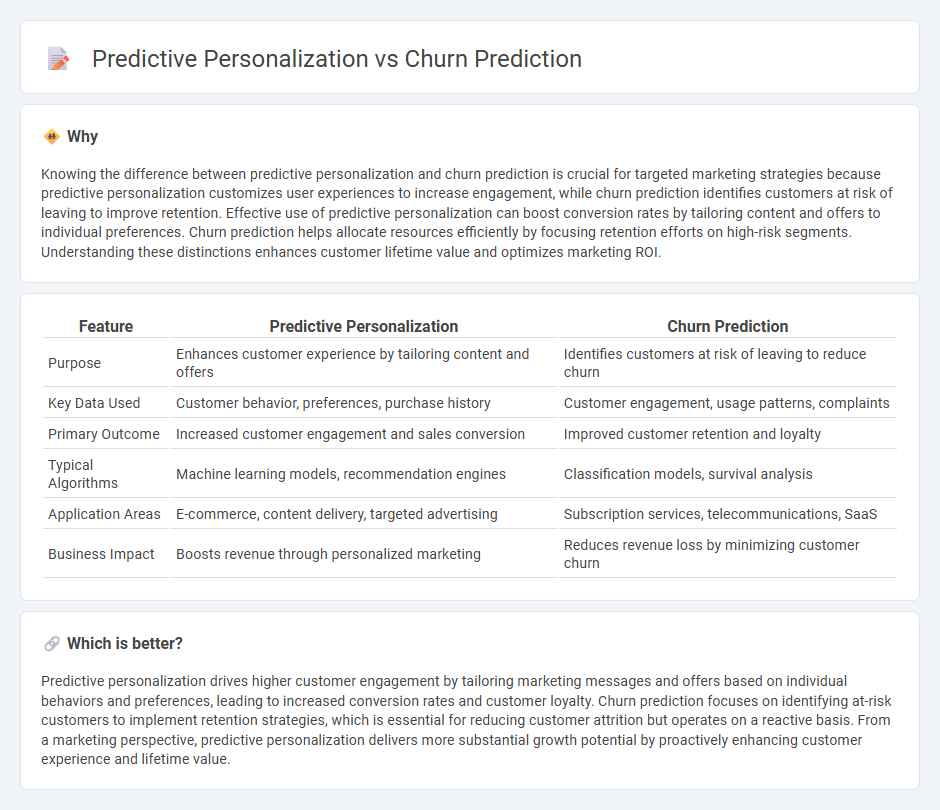
Predictive personalization uses customer data to tailor marketing messages and product recommendations, enhancing user engagement and conversion rates. Churn prediction identifies customers likely to stop using a service, enabling targeted retention strategies to reduce revenue loss. Explore how these data-driven approaches transform marketing effectiveness and customer loyalty.
Why it is important
Knowing the difference between predictive personalization and churn prediction is crucial for targeted marketing strategies because predictive personalization customizes user experiences to increase engagement, while churn prediction identifies customers at risk of leaving to improve retention. Effective use of predictive personalization can boost conversion rates by tailoring content and offers to individual preferences. Churn prediction helps allocate resources efficiently by focusing retention efforts on high-risk segments. Understanding these distinctions enhances customer lifetime value and optimizes marketing ROI.
Comparison Table
| Feature | Predictive Personalization | Churn Prediction |
|---|---|---|
| Purpose | Enhances customer experience by tailoring content and offers | Identifies customers at risk of leaving to reduce churn |
| Key Data Used | Customer behavior, preferences, purchase history | Customer engagement, usage patterns, complaints |
| Primary Outcome | Increased customer engagement and sales conversion | Improved customer retention and loyalty |
| Typical Algorithms | Machine learning models, recommendation engines | Classification models, survival analysis |
| Application Areas | E-commerce, content delivery, targeted advertising | Subscription services, telecommunications, SaaS |
| Business Impact | Boosts revenue through personalized marketing | Reduces revenue loss by minimizing customer churn |
Which is better?
Predictive personalization drives higher customer engagement by tailoring marketing messages and offers based on individual behaviors and preferences, leading to increased conversion rates and customer loyalty. Churn prediction focuses on identifying at-risk customers to implement retention strategies, which is essential for reducing customer attrition but operates on a reactive basis. From a marketing perspective, predictive personalization delivers more substantial growth potential by proactively enhancing customer experience and lifetime value.
Connection
Predictive personalization leverages customer data to tailor marketing strategies that enhance user experiences, while churn prediction identifies patterns indicating potential customer loss. Integrating churn prediction with predictive personalization enables marketers to deliver targeted interventions aimed at retaining at-risk customers. This synergy improves customer retention rates and maximizes lifetime value through data-driven, individualized marketing efforts.
Key Terms
**Churn Prediction:**
Churn prediction utilizes machine learning algorithms to analyze customer behavior patterns, transaction history, and engagement metrics, enabling businesses to identify at-risk customers before they exit. By focusing on factors like purchase frequency, customer service interactions, and demographic data, companies can implement targeted retention strategies to reduce revenue loss. Discover how leveraging churn prediction models can optimize customer lifetime value and enhance loyalty programs.
Attrition Rate
Churn prediction models analyze customer behavior and transaction data to identify individuals at high risk of attrition, enabling targeted retention strategies that reduce overall Attrition Rate. Predictive personalization leverages these insights to tailor marketing messages and product recommendations, enhancing customer engagement and loyalty. Explore how integrating churn prediction with predictive personalization can significantly decrease Attrition Rate and boost customer lifetime value.
Customer Lifetime Value (CLV)
Churn prediction models analyze customer behavior and transaction history to identify individuals at risk of leaving, thereby enabling targeted retention strategies that maximize Customer Lifetime Value (CLV). Predictive personalization leverages machine learning algorithms to tailor experiences and offers based on customer preferences, increasing engagement and boosting CLV over time. Discover how integrating churn prediction with predictive personalization can significantly enhance your CLV optimization efforts.
Source and External Links
Mastering Churn Prediction: Strategies for Improved Customer ... - Churn prediction models analyze historical customer data to identify early warning signs of customers likely to stop using a product, allowing companies to prioritize high-risk customers and trigger targeted actions based on behavioral data and customer interactions.
Predicting & Preventing Churn: Building a Churn Prediction Model - Churn prediction involves identifying customers at risk of leaving or canceling subscriptions by analyzing their behavior to enable proactive retention efforts like customer outreach and re-engagement campaigns.
Churn prediction explained | Stripe - Effective churn prediction depends on quality data collection and integration from multiple sources such as transactional data, customer interactions, and social media, along with data cleaning and privacy safeguards to build reliable predictive models.
 dowidth.com
dowidth.com